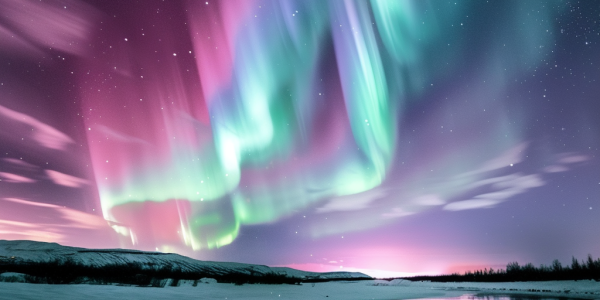Solar Maximum: Exciting Times for Skywatchers and Scientists Ahead
The sun is currently experiencing solar maximum, leading to increased solar flares and breathtaking auroras visible from Earth. This active phase of the 11-year solar cycle is expected to continue for another year, providing exciting opportunities for skywatchers and scientists alike. The Parker Solar Probe is set to make its closest approach to the sun, allowing for unprecedented data collection on solar activity and its impact on space weather.
Northern Lights: Beauty Amidst Solar Storm Risks
The Northern Lights, or aurora borealis, are captivating displays that have gained attention due to heightened solar activity this year. While geomagnetic storms have reached as far south as Arizona and Florida, experts assure that observing the auroras is safe. However, solar flares and coronal mass ejections pose risks to technology and infrastructure, making awareness and preparedness essential for enjoying this natural phenomenon.
Harnessing Machine Learning for Enhanced Solar Weather Forecasting in Space Operations
As satellite operators face challenges from solar weather, advancements in machine learning are enhancing space weather forecasting. Researchers are utilizing data from NASA’s Solar Dynamics Observatory to develop predictive models that improve satellite tracking during solar events. This innovative approach is crucial for maintaining operational advantages in increasingly contested space environments.
Significant Solar Flare Erupts, Causing Radio Blackouts and Auroras Expected on Earth
A powerful solar flare from sunspot AR3842 has erupted, causing radio blackouts and potential geomagnetic storms on Earth. This second strongest flare of the solar cycle, observed by NASA’s SDO, has already disrupted communications in Hawaii and could lead to visible auroras in northern US states. Stay informed about the implications of solar activity and its effects on technology as experts monitor the situation.
Autumnal Equinox to Coincide with Minor Geomagnetic Storm
As autumn arrives, a minor geomagnetic storm is expected on September 12, 2024, coinciding with the autumnal equinox. Triggered by a recent solar flare and coronal mass ejection, this event will enhance auroras at lower latitudes, captivating astronomy enthusiasts and nature lovers alike. Experts from NOAA classify the storm as G1, indicating minimal disruptions to satellite communications and power grids. Stay informed about this celestial phenomenon and its impact on Earth.
Central Maine Prepares for Northern Lights Spectacle Amid Solar Storm
Central Maine residents are excited for the upcoming solar storm that may reveal the northern lights, or aurora borealis. The National Oceanic and Atmospheric Administration (NOAA) predicts peak visibility around 2 a.m. on Wednesday, with optimal viewing in areas like Skowhegan. This year has been favorable for aurora sightings, and local experts advise finding dark locations for the best chance to witness this stunning natural phenomenon.
Massive Solar Storm Triggers Stunning Northern Lights Display Across US
A massive solar storm triggered ‘extreme’ levels of geomagnetic activity, leading to the Northern Lights being visible as far south as Florida. Aurora enthusiasts witnessed vibrant hues not seen in years, with the Space Weather Prediction Center reporting an ‘extreme’ event. While the mesmerizing auroras captivate onlookers, the broader implications of solar storms highlight the vulnerability of modern technology to space weather phenomena.
Geomagnetic Storm to Create Stunning Aurora Lights Across the U.S.
Exciting news for skywatchers in the United States as a geomagnetic storm is set to create stunning aurora lights across the country. The NOAA’s Space Weather Prediction Center has reported powerful solar flares from region 3663 of the Sun, potentially leading to spectacular Northern Lights displays in the northern U.S. Keep an eye out for the mesmerizing auroras and enjoy the beauty of nature’s light show!
NASA Studies Solar Storms to Prepare for Mars Missions
NASA is preparing to study the effects of solar storms on Mars missions as the sun enters a period of heightened activity. Solar events like flares and mass ejections pose a threat to Mars due to its lack of a magnetic field. MAVEN and Curiosity rover are key in monitoring radiation levels and analyzing the impact on potential ancient life indicators. Understanding these phenomena is crucial for ensuring the safety of future astronauts exploring the Red Planet.
NASA Observes Strong Solar Flare from the Sun
The Sun emitted a strong solar flare, peaking at 4:56 p.m. ET on March 28, 2024. Solar flares can impact radio communications, electric power grids, navigation signals, and pose risks to spacecraft and astronauts. This flare is classified as an X1.1 flare, denoting the most intense flares. To see how such space weather may affect Earth, please visit NOAA’s Space Weather Prediction Center, the U.S. government’s official source for space weather forecasts, watches, warnings, and alerts.










